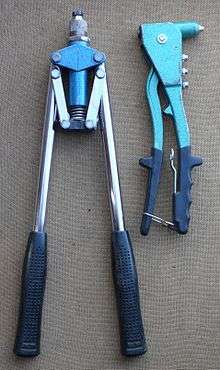Rivet gun

A rivet gun, also known as a pneumatic hammer,[1] is a type of tool used to drive rivets. The rivet gun is used on the manufactured head side of the rivet and a bucking bar is used on the buck-tail side of the rivet. The energy from the hammer in the rivet gun drives the work and the rivet against the inertia of the bucking bar. As a result, the tail of the rivet is deformed and work-hardened. At the same time the work is tightly drawn together and retained between the rivet head and the broadened and flattened tail. Nearly all rivet guns are pneumatically powered. Those rivet guns used to drive rivets in structural steel are quite large while those used in aircraft assembly are easily held in one hand. A rivet gun differs from an air hammer in the precision of the driving force.
Rivet guns vary in size and shape and have a variety of handles and grips. Pneumatic rivet guns typically have a regulator which adjusts the amount of air entering the tool. Regulated air entering passes through the throttle valve which is typically controlled by a trigger in the hand grip. When the trigger is squeezed, the throttle valve opens, allowing the pressurized air to flow into the piston. As the piston moves, a port opens allowing the air pressure to escape. The piston strikes against the rivet set. The force on the rivet set pushes the rivet into the work and against the buck. The buck deforms the tail of the rivet. The piston is returned to the original position by a spring or the shifting of a valve allowing air to drive the piston back to the starting position.
Slow-hitting
The slow-hitting gun strikes multiple blows as long as the trigger is held down. The repetition rate is about 2,500 blows-per-minute (bpm). It is easier to control than a one-hit gun. This is probably the most common type of rivet gun in use.
Fast-hitting gun
The fast-hitting gun strikes multiple light-weight blows at a high rate as long as the trigger is held down. These are repeated in the range of 2,500 to 5,000 bpm. The fast-hitting gun, sometimes referred to as a vibrator, is generally used with softer rivets.
Corner riveter
The corner riveter is a compact rivet gun that can be used in close spaces. The rivet is driven at right-angles to handle by a very short barreled driver.
Squeeze riveter
This gun is different from the above rivet guns in that the air pressure is used to provide a squeezing action that compresses the rivet from both sides rather than distinct blows. The squeeze riveter can only be used close to the edge because of the limited depth of the anvil. Once properly adjusted, the squeeze riveter will produce very uniform rivet bucks. The stationary (fixed) jaw is placed against the head and the buck is compressed by the action of the gun.
pop rivet gun


See also
References
- ↑ Popular Science Monthy, 93, Modern Publishing Companry, 1918, p. 406.
Further reading
- Bureau of Naval Personnel - [US] Navy Training Course Aviation Structural Mechanic S 3 & 2 NavPers 10308-A. U.S. Navy Training Publications Center, Memphis, Tennessee, 1966, 380 pages